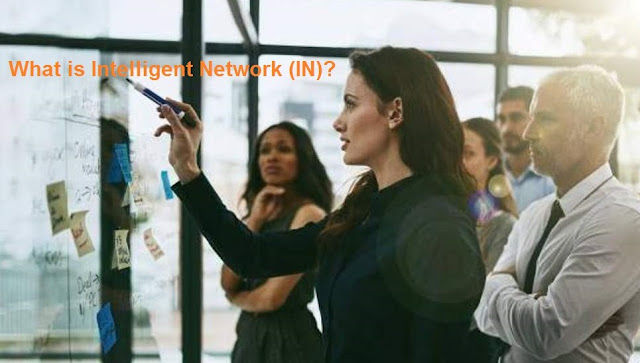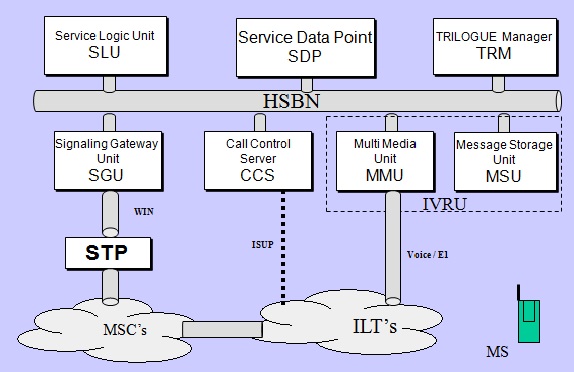What is Intelligent Network (IN)?: A telephone network architecture that separates service logic from switching equipment, allowing new services to be added without redesigning switches to support those new services. After little improvement later version of Intelligent Network (IN) called the Advanced Intelligent Network (AIN) . Advanced Intelligent Network (AIN) makes it easy to add new services without having to install new phone equipment.
Intelligent Network (IN) Services
➥Calling Card
➥VPN Free Phone , Etc
Prepaid service reverses the traditional method of paying for telephony services. With traditional post-paid service, subscribers first use the service by making and receiving calls and are later billed for that use, usually on a monthly basis.
With prepaid telephony, subscribers pay before they use the service. Subscribers buy a certain amount of service by prepaying a certain amount of money, and can use the service up to the amount purchased. Once that amount is used, subscribers have to prepay again to continue using the service.
Introduction to Com-verse Prepaid System
➥MultiMedia Unit (MMU)
➥Messaging and Storage Unit (MSU)
➥Service Data Point (SDP)
➥Call Control Server (CCS)
➥High Speed Backbone Network (HSBN)
➥Administrative Local Area Network (Admin-LAN)
➥Trilogue Manager (TRM)
➥Remote Maintenance Unit (RMU)
➥Remote Access Unit (RAU)
➥Service Administration Workstation (SAW)
The Trilogue Manager (TRM) hosts several functions such as the Host Interface for Administration (HIA), the Integrated Alarm Package (IAP) and the Billing Interface Package (BIP). It is also used as a gateway to some other systems such as an SMSC or a paging gateway.
The Signaling Gateway Unit (SGU) is the component which controls all IN calls and talks to the SLU. Signalling Gateway Unit supports WIN , MAP.
As the controlling component of the prepaid system, the Service Logic Unit (SLU) is an integral part of the Comverse architecture. The SLU interfaces with the SDP in order to manage, access and use the resources of the prepaid system.
The Call Control Service (CCS) is the component which handles all ISUP calls and talks to the SLU. CCS route incoming and outgoing call information to the MMU. CCS Interfaces with other components via LAN/HSBN.
The Service Data Point (SDP) is the database which holds all subscriber information. The Service Data Point (SDP) is a powerful database server system for the Comverse line of Intelligent Network (IN) value added services. A stand-alone system, it operates in conjunction with one or several PPS components.
It provides high capacity storage, is fully redundant, and can be scaled to support the most demanding networks and configurations. The SDP provides the necessary back-end database services to these front-end systems.
The IVRU is a sub-system that provides the voice resources for any calls which require them.The MMUs and MSUs of the Interactive Voice Response Unit (IVRU) provide the capabilities to play voice announcements and collect DTMF digits over the voice channels under the control of the SLU.
The IVRU is used when announcements are played to callers, or when DTMF input is collected. The IVRU is connected via voice channels to the switch, so that any call can be switched and connected to an IVRU port. The IVRU also operates under full SLU control, according to the service logic.
Messages between MSC & SCP
ANLYZD➨ Analyzed Information Invoke
BULKDISCONN➨ Bulk Disconnect Invoke
Intelligent Network (IN) is a network that provide extra services that are not included as basic features, but are associated with the basic services by enhancing and/or adding extra features to the basic services. these services are provided as a basic or supplementary service, it is not only important to know what is transmitted. How the transmission is carried out plays a major role, too. In addition, there is the question of whether sufficient resources are available to support the service from end to end.
 |
| Intelligent Network (IN) details |
"Intelligent Network (IN) Services" often used in telecom networks,these networks can separate extra services from the call switching system, making it easier to add new user services. Services provided by Intelligent Network (IN) are mentioned below-
➥Prepaid ➥Calling Card
➥VPN Free Phone , Etc
What is Prepaid?
An Intelligent Network Prepaid Platform is a system of components used to manage and control telephone calls.The Prepaid Service is part of a large family of value-added services that network operators and service providers use on the Prepaid system.
➤The TRILOGUE INfinity PPS is composed of the following components:
➥Service Logic Unit (SLU, both N+1 and 2N)➥MultiMedia Unit (MMU)
➥Messaging and Storage Unit (MSU)
➥Service Data Point (SDP)
➥Call Control Server (CCS)
➥High Speed Backbone Network (HSBN)
➥Administrative Local Area Network (Admin-LAN)
➥Trilogue Manager (TRM)
➥Remote Maintenance Unit (RMU)
➥Remote Access Unit (RAU)
➥Service Administration Workstation (SAW)
 |
| Prepaid system |
Wireless Intelligent Network CDMA is based on IS-826 standards, which is subset of IS- 41 standard. IS-826 standards will be used to explain typical WIN setup. Below mentioned triggers are mentioned in IS-826 publication for WIN.
Triggers armed for Originationg Calls
Origination_Request_Authorized
Calling_Routing_Address_Available
O_Answer
O_Disconnect
Triggers armed for Terminating Calls
Initial_Termination
Called_Routing_Address_Available
T_Answer
T_Disconnect
Triggers armed for Originationg Calls
Origination_Request_Authorized
Calling_Routing_Address_Available
O_Answer
O_Disconnect
Triggers armed for Terminating Calls
Initial_Termination
Called_Routing_Address_Available
T_Answer
T_Disconnect
 |
| Signaling Gateway in Intelligent Network |
As the controlling component of the prepaid system, the Service Logic Unit (SLU) is an integral part of the Comverse architecture. The SLU interfaces with the SDP in order to manage, access and use the resources of the prepaid system.
It provides high capacity storage, is fully redundant, and can be scaled to support the most demanding networks and configurations. The SDP provides the necessary back-end database services to these front-end systems.
The IVRU is used when announcements are played to callers, or when DTMF input is collected. The IVRU is connected via voice channels to the switch, so that any call can be switched and connected to an IVRU port. The IVRU also operates under full SLU control, according to the service logic.
Messages Received by the SCP
The following is the list of messages received by the SCP. Note that messages in Upper case are invoke messages. Lower case messages are the response messages to the corresponding invoke messages in Upper case.
The following is the list of messages received by the SCP. Note that messages in Upper case are invoke messages. Lower case messages are the response messages to the corresponding invoke messages in Upper case.
ANLYZD➨ Analyzed Information Invoke
BULKDISCONN➨ Bulk Disconnect Invoke
CCDIR➨ Call Control Directive response
CRREPORT➨ Call recovery Report Invoke
OANSWER➨ Originating Answer Invoke
ODISCONNECT➨ Originating Disconnect Invoke
ORREQ➨ Origination Request Invoke
SERVREQ➨ Service Request Invoke
TANSWER➨ Terminating Answer Invoke
TDISCONNECT➨ Terminating Disconnect Invoke
UNRELCALLDATA➨ Unrelaible call data response
Call Scenarios -- IVRU Calls
There are two types of IVR calls - Correlated, and Non-Correlated.
OANSWER➨ Originating Answer Invoke
ODISCONNECT➨ Originating Disconnect Invoke
ORREQ➨ Origination Request Invoke
SERVREQ➨ Service Request Invoke
TANSWER➨ Terminating Answer Invoke
TDISCONNECT➨ Terminating Disconnect Invoke
UNRELCALLDATA➨ Unrelaible call data response
There are two types of IVR calls - Correlated, and Non-Correlated.
A Correlated call is one where the SLU determines that a pre-call announcement needs to be played for the subscriber, either before the call is terminated (such as lack of balance), or before the call is routed to the dialed number (a low balance warning)
A Non-Correlated call is one where the subscriber has initiated an IVR session directly (such as a call placed to the recharge server).
This Flow assumes the Subscriber Balance is positive and the account is in the Active state.
1. The IN signaling was routed from the Network Switch to the SGU.
2. The SGU routes the converted signal to the SLU.
3. The SLU will extract account data from the IN message to validate the account.
4. The SLU and SDP engage in a dbquery session to retrieve the Subscriber’s record from the database.
5. SLU issues three messages to the SGU to be forwarded to the Network Switch. ➥Request Report BCSM Event message – to set the events monitored by the SSP
➥Apply Charging message – to set the charging events
➥Connect message - to order the SSP to go ahead with the call.
6. The SGU forwards the SLU messages to the Network Switch.
Request Report BCSM Event message – to set the events monitored by the SSP
A Non-Correlated call is one where the subscriber has initiated an IVR session directly (such as a call placed to the recharge server).
 |
| Call flow overview in Intelligent Networ (IN) |
Now in below image you can see the originating call process in Intelligent Network (IN).
 |
| IN Originating Call |
1. The IN signaling was routed from the Network Switch to the SGU.
2. The SGU routes the converted signal to the SLU.
3. The SLU will extract account data from the IN message to validate the account.
4. The SLU and SDP engage in a dbquery session to retrieve the Subscriber’s record from the database.
5. SLU issues three messages to the SGU to be forwarded to the Network Switch. ➥Request Report BCSM Event message – to set the events monitored by the SSP
➥Apply Charging message – to set the charging events
➥Connect message - to order the SSP to go ahead with the call.
6. The SGU forwards the SLU messages to the Network Switch.
Request Report BCSM Event message – to set the events monitored by the SSP
Apply Charging message – to set the charging events
Connect message - to order the SSP to go ahead with the call.
7. The call is connected.
8. The message EventReportBCSM is sent to the SLU via the SGU to begin charging for the call.
9. When the call is disconnected by one of the parties, the SSP sends to the SCP
another EventReportBCSM message followed by an ApplyChargingReport message containing charge events and data.
Connect message - to order the SSP to go ahead with the call.
7. The call is connected.
8. The message EventReportBCSM is sent to the SLU via the SGU to begin charging for the call.
9. When the call is disconnected by one of the parties, the SSP sends to the SCP
another EventReportBCSM message followed by an ApplyChargingReport message containing charge events and data.
10. Call termination:
A TCAP TC_END message terminates the call flow
When passed, the corresponding dialog is closed.
The Network Switch determines whether to use basic-end or pre-arranged end.
SCP will return a ReleaseCall message only if the last INAP message received from the SSP was within a TCAP TC_CONTINUE message.
11. The SLU completes the billing operation, closes the subscriber record, and transmits the data to the SDP.
A TCAP TC_END message terminates the call flow
When passed, the corresponding dialog is closed.
The Network Switch determines whether to use basic-end or pre-arranged end.
SCP will return a ReleaseCall message only if the last INAP message received from the SSP was within a TCAP TC_CONTINUE message.
11. The SLU completes the billing operation, closes the subscriber record, and transmits the data to the SDP.
 |
| Intelligent Network (IN) Terminating Call |
In addition, there is the question of whether sufficient resources are available to support the
service from end to end. It may be that the service is available at one end, but the target user may not have access to it and hence the use of this service is not possible. Basically, there are three essential points that need to be fulfilled before a service becomes available.
1.Whether the subscriber has access to the service or not?
2. Whether the GSM network from where the user is getting the service has the necessary resources or not?
3. Whether the equipment owned by the user is capable of supporting the service or not?




0 Comments